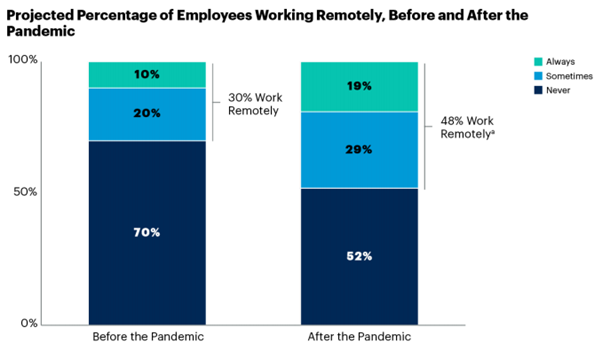
Meetings are potentially one of the most controversial topics you can raise with colleagues. But the fact of the matter is, love them or hate them, they’re here to stay.
In fact, the average amount of meetings attended increased by 12.9% in lockdown. Yet almost half of all employees deem them to be a waste of time.
So how can you make sure you’re utilizing work meetings in a way that benefits your business and all your stakeholders and get the most value possible from them?
One way is to record meetings. And today, we’re going to list eight vital reasons why you should.
1. Increase Focus
So you’ve planned the perfect meeting, you’ve got your notes, everything’s organized. But then the meeting comes, and everyone’s got their heads buried in their notebooks/laptops.
See, the problem is, if employees are worried about retaining important info and taking notes, they’re not going to be able to focus and absorb the information fully. Their attention will be on making sure they don’t miss anything.
And, ironically, that’s the best way to miss something.
By recording the meeting, people know that they can go back and access it later in the recording if they do miss something. This gives them the peace of mind they need to put their pens down and actually listen.
As an added bonus, you’ll probably get more participation (if that’s what you’re looking for).
Remote meeting hacks to increase focus involve changing up your communication methods. Add in an interactive element, like screen sharing or a virtual whiteboard to keep employees engaged.
2. Promote an Open Culture

Some companies record all their meetings and store the recordings in an online database where they’re accessible to everyone. We recommend the cloud for this. Indeed cloud migration services have been central to the wider digital transformation.
You might choose to store only some meetings as opposed to all of them, in the case that some contain sensitive information. The point is, this creates an open culture in the company. Employees – and leaders – can access information about how a decision was made and who the key players are.
A transparent culture in an organization facilitates access to information, which in turn promotes productivity and retention in employees.
If you do choose to upload all your meeting recordings to a cloud service, we recommend making sure you’re using an adequate internet connection to avoid painfully slow upload and streaming speeds. There are a number of high-speed business internet providers out there that can meet these needs.
3. Simplify Scheduling
We’re all familiar with the endless back-and-forth between meeting leaders and invitees. Emails and phone calls are exchanged to find the most suitable time according to everyone’s availability.
The situation is further complicated when you work with colleagues spread across the globe (make sure they’re using SIP trunking if they’re calling you from abroad!).
Ideally, we want to find a timeframe that works for everyone. But in the likely scenario that some key players can’t attend, it’s less of a big deal if there’s going to be a recording. After all, they can just access the recording at their own convenience and catch up on everything that was discussed.
As a side-note, you can use an online scheduling tool to make the process even easier. This avoids the need to find a time that suits everyone manually by syncing to your calendar and automating the process.
4. Remove Geographical Barriers

As we touched on before, you might have colleagues spread across the globe and, therefore, need to set up a hybrid meeting.
After all, the digital nomad trend is in full swing and increasingly since the pandemic. This can make it even more challenging to find a suitable time for everyone to attend the meeting live.
In fact, in some cases, that might be downright impossible (ever tried scheduling a meeting with one person in the States and one in Australia? Yeah, good luck with that…).
If your meetings are recorded, this removes the pressure for all invitees to attend live.
This allows you to open up the meeting to people in different areas, countries, or even continents. Timezone differences are no longer an issue since people can simply watch the recording if they can’t make it live!
5. Increase Accountability
Have you ever come out of a meeting and immediately entered into a disagreement with someone about the next steps?
“No, they said we should start by creating a spreadsheet.”
“I’m sure they said we should reach out to the Michigan branch first.”
The fact is, some people will register one piece of information while others will remember something else. Again, if this was a lengthy meeting with lots of calls to action, can you blame them?
But this also goes for shorter, simpler meetings. It can be difficult to make sure everyone’s on the same page.
To exacerbate the problem, everybody multitasks during meetings. Catching up on emails, text messages, updating that Netflix watch-list, or looking up healthy recipes, it seems like everyone’s made the silent agreement that meetings are the perfect opportunity to catch up on a bit of life admin. We’re all guilty of it…
With a recording, however, everyone has the ability to check back to see exactly what was said and what the next steps are.
Now nobody can say they were unclear on these because they missed the meeting. Nor can they blame the meeting minutes for having missed out on critical details.
Plus, it’s great to have the recording for easy referencing in case this is a project that will span over the course of several months or years.
6. Facilitate Prioritizing

With in-person, live meetings, employees or leaders are often obliged to choose either to put aside important, time-sensitive tasks to attend an equally critical meeting or just miss this entirely.
It’s a difficult decision to make. In fact, employees list meetings as the 4th most common cause of interruptions at work.
With recorded meetings, this no longer has to be an issue. If there’s a pressing task at hand, people can decide to skip the meeting to prioritize this task and simply catch up on the recording later!
This way, you get the best of both worlds without having to make an impossible choice.
7. Increase the Value of the Meeting
It’s a well-known fact that people are more likely to stay on topic if they know they’re being recorded. It kind of seems like common sense if you think about it, but there’s also research to back it up.
But not only that, meeting leaders will take extra care to make sure the information relayed and the topics discussed are extra clear. They’ll usually provide additional clarification because they know people watching later won’t be able to ask questions.
What’s more, recorded meetings provide a great learning opportunity. Meeting leaders can watch themselves leading the meeting and pick out areas for improvement. The recordings can also act as great support for feedback sessions with managers or training sessions for future meeting leaders.
8. Avoid Repetition
We’ve saved the most obvious one for last because it’s also the one that gets forgotten about most often.
Think about it: why do you record things on TV? It’s so you can refer back to it over and over again without needing to wait for a repeat.
So how can we apply this to a business environment? Well, what if the meeting taking place is a training session?
Let’s say you’re giving cold calling training, and you share a list of cold-calling scripts.
Your trainees will likely want to access this list again.
Using the same example of cold calling training, let’s say you’re introducing the concept of automated dialler systems. This will likely be a longer, more involved session that employees will want to refer back to as they practice cold-calling.
Recording this session allows them to do so – and stops you from needing to repeat the information over and over.
What’s more, you could even use the recording as a training resource next time, instead of repeating the exact same training meeting. Your trainer will thank you for not making them repeat the same information, and you’ll free up their time to do something new.
Or maybe it’s a highly informative meeting that could benefit other members of the organization, but you don’t necessarily need them in the meeting. In this case, all you would need to do is record the meeting and grant access to the recording to all interested parties.
On a final note, by recording meetings and training sessions, you’re documenting essential info, so you have it even if the expert leaves the company.
Recording: The Best Way to Maximize Value From Your Meetings
Why just have in-person meetings when you can go one step further than that and extract tons of value by recording them.
And let’s not forget, the reasons we listed above don’t just apply to meetings with colleagues. They also apply to virtual events with customers, online workshops, and webinars… pretty much any type of online meeting.
This is why we recommend recording all your meetings. Download our new version of Meeting Recorder Plus and don’t miss a thing!
